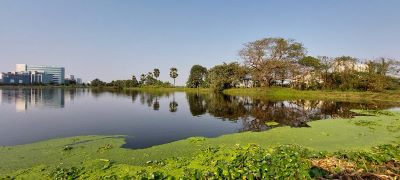Context-
Bengaluru, once known as Kalyana Nagara or the City of Lakes, is now grappling with a severe water crisis that has led to apocalyptic scenarios resembling those from a thriller novel. The city's residents are facing unprecedented challenges, including dry taps, reliance on water tankers, exorbitant rates for water, and strict regulations on water usage. The situation has been exacerbated by below-normal monsoon seasons, attributed in part to the impact of El Niño.
In light of these challenges, it is imperative to revisit Bengaluru's historical relationship with water and the ecological significance it holds. This analysis looks into the intricate dynamics of Bengaluru's waterscape, tracing its evolution from a city abundant in lakes and ponds to one struggling with scarcity and inequity.
Historical Context: Bengaluru as the City of Lakes
Bengaluru's traditional water management system was a marvel of human ingenuity, characterized by the creation of lakes, ponds, and wells that sustained the city's water needs. These water bodies, including keres (lakes), kalyanis (temple ponds), and gokattes (cattle washing ponds), served as vital sources of water for various purposes, ranging from drinking and irrigation to cultural and social activities. The interconnectedness of these water bodies facilitated groundwater recharge and supported diverse livelihoods within the community.
Urbanization and Transformations in Bengaluru's Waterscape
The urbanization of Bengaluru brought about significant changes in its waterscape, driven by factors such as colonial interventions, post-independence development initiatives, and the emergence of the city as India's software capital. Lakes were encroached upon or repurposed for urban infrastructure, while wetlands and water channels were filled to make way for residential and commercial projects. The rapid expansion of the city led to a disproportionate distribution of water resources, with affluent areas benefiting from municipal piped water systems while marginalized communities struggled to access clean water for their basic needs.
Current Challenges: Inequity and Scarcity
Present-day Bengaluru grapples with profound inequities in water access, highlighting the failure of governance and planning to ensure equitable distribution of this essential resource. While affluent neighborhoods rely on municipal water supplies and private borewells, marginalized communities resort to water tankers or face acute shortages. The right to water, recognized as a fundamental human right, remains elusive for a significant portion of the city's population, perpetuating socio-economic disparities.
Government Interventions and Policy Framework
Efforts to address Bengaluru's water crisis have been reflected in various laws, guidelines, and schemes aimed at water conservation, rainwater harvesting, and sewage treatment. However, the implementation of these initiatives has been inadequate, evident in the persistent water scarcity plaguing the city. The reliance on distant water sources, such as the Cauvery River, and the exploitation of groundwater through borewells underscore the urgency of reevaluating water management strategies.
The Three Rs: Rethinking Bengaluru's Relationship with Water
To navigate the complexities of Bengaluru's water crisis, a paradigm shift is needed, encapsulated in the concept of the three Rs: relationship, rights, and responsibilities.
Reconnecting with Water: Restoring Bengaluru's lost connection with its water heritage entails revitalizing remnant lakes, ponds, and wells as integral components of the city's social and cultural fabric. Embracing traditional water management practices and acknowledging the intrinsic value of water bodies can foster a renewed sense of stewardship among residents.
Ensuring Equal Rights to Water: Addressing socio-economic disparities in water access requires a concerted effort to ensure that every resident, regardless of their economic status, enjoys equitable rights to water. Policies aimed at democratizing water distribution and prioritizing the needs of marginalized communities are essential for building a more inclusive and sustainable urban environment.
Embracing Responsibility for Water Sustainability: Recognizing water as a shared resource necessitates individual and collective responsibility for its sustainable use. Educating citizens about water conservation practices, promoting water-efficient technologies, and holding stakeholders accountable for environmental stewardship are crucial steps in mitigating Bengaluru's water crisis.
Towards a Water-Resilient Bengaluru
As Bengaluru grapples with the dual challenges of scarcity and flooding, it is imperative to break free from the cycle of crisis and embrace a proactive approach to water management. By embracing the principles of the three Rs and fostering a culture of water conservation and stewardship, Bengaluru can chart a path towards a more resilient and water-secure future.
Conclusion
Bengaluru's water crisis represents a critical juncture in the city's history, demanding urgent action and collective commitment to reimagine its waterscape. By rekindling its relationship with water, ensuring equal rights for all residents, and embracing responsibility for sustainable water management, Bengaluru can overcome its current challenges and emerge as a model for urban resilience and sustainability. Only through concerted efforts and inclusive governance can Bengaluru realize its vision of a water-secure future for generations to come.
|
Probable Questions for UPSC Mains Exam- 1. How has the historical evolution of Bengaluru's waterscape, from being known as the "City of Lakes" to facing a severe water crisis, reflected broader socio-economic and urban development trends in the region? (10 Marks, 150 Words) 2. What are the key challenges and disparities in water access that currently characterize Bengaluru and other cities, and how do these issues intersect with issues of governance, policy implementation, and socio-economic inequality? (15 Marks, 250 Words) |
Source- The Indian Express







